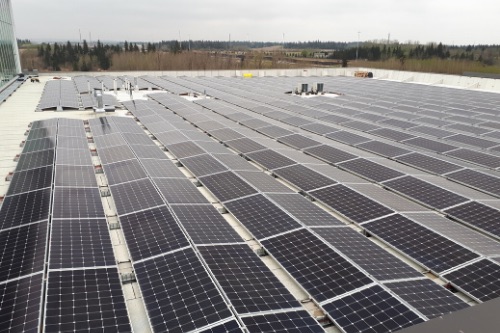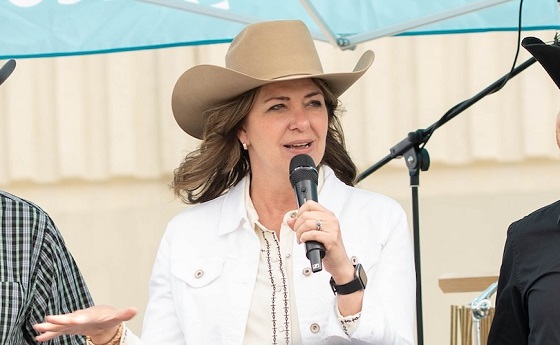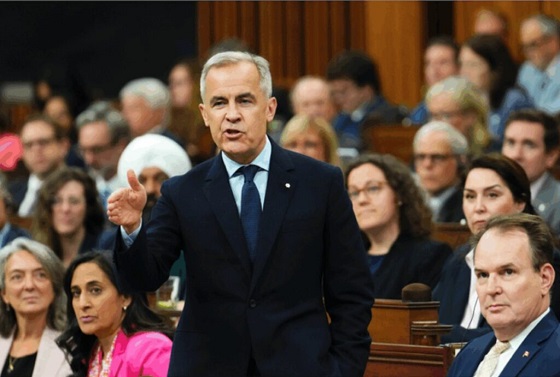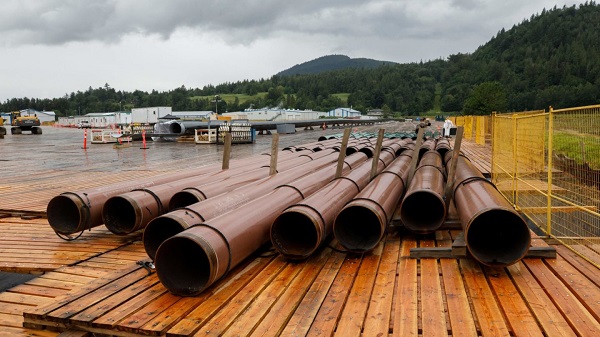Alberta
National recognition for RDC’s Alternative Energy Initiative

RDC’s Alternative Energy Initiative recognized nationally as a leader in sustainability
Red Deer College’s commitment to environmental stewardship has been recognized on the national stage with two honours.
The College is proud to be recognized by Clean50 for its use of sustainable technologies to provide learning and research opportunities for students, faculty and industry partners, as well as to reduce its energy consumption. In addition, RDC’s Alternative Energy Lab has received LEED (Leadership in Energy and Environmental Design) Silver certification from Canada Green Building Council.
Clean50 Top Project for 2021
RDC’s Alternative Energy Initiative has been named one of Canada’s Clean50 Top Project Award (https://clean50.com) winners and this project has been declared a Clean50 Top Project for 2021.
Clean50 celebrates innovation among organizations who contribute to a sustainable low-carbon Canadian economy to expedite collaboration and constructive change.
“RDC takes great pride in receiving this national recognition as a leader in sustainable technology, through the reduction of the College’s overall carbon footprint,” says Dr. Peter Nunoda, RDC President. “The Alternative Energy Lab, which is part of the College’s larger Alternative Energy Initiative, is a hub for alternate energy education and research, in addition to providing RDC’s faculty and students with opportunities to collaborate with, and support, central Alberta businesses.”
RDC’s Alternative Energy Initiative provides a framework to guide the College’s development as an alternative energy technology leader, reducing operational utility demands and costs.
The project submitted by RDC to Clean50 highlighted initiatives such as the College’s installation of more than 4,200 solar panels, which is the largest array among Canadian post-secondary schools, as well as a combined heat and power unit, replacement of exterior lighting with new energy efficient LEDs, and the Alternative Energy Lab, which is a vital teaching and learning space.
“RDC’s alternative energy projects play a significant role in reducing the institution’s carbon footprint which positively impact RDC’s operations and the environment. Electricity production at the College from alternative energy sources equates to powering 1,300 homes or removing 1,100 cars off the road each year,” says Jason Mudry, RDC’s Director of Campus Management.
“These projects also help RDC drastically reduce its utility costs by up to $750 thousand annually. These savings provide funds for use in other educational and operational initiatives.”
RDC’s Alternative Energy Initiative has vastly trimmed RDC’s use of external sources of electricity. At times, the College is able to sell power to surrounding communities in central Alberta as the largest independent electrical producer in Red Deer.
LEED Silver Certification for RDC’s Alternative Energy Lab
The College’s Alternative Energy Lab is among the newest learning spaces on RDC’s main campus, opening in 2019. This nationally-recognized LEED Silver certification highlights the College’s efforts to ensure the Lab embodies sustainability in its design, construction and ongoing operation.
“RDC’s Alternative Energy Lab offers tremendous value to a variety of stakeholders, including to more than one thousand students annually in a wide range of programs,” says Kylie Thomas, RDC Vice President Academic & Research. “The Lab enhances the entire immersive alternative energy educational experience for our students by offering an engaging platform to learn about these systems and apply their knowledge and skills to real-world situations. These incredible opportunities help prepare our learners for a variety of promising careers in the growing sector of alternative energy.”
Canada Green Building Council recognized RDC’s Alternative Energy Lab with LEED Silver certification for reasons including:
- the facility was built with a high-performance building envelope that has about fifty per cent more insulation value than a typical building
- an extensive photovoltaic array attached to the building that produces a significant amount of electricity for use in the Lab and other locations of main campus
- the Lab uses high-efficiency building mechanical systems to reduce energy consumption
RDC is also LEED certified with its Four Centres and Gary W. Harris Canada Games Centre. RDC’s new Residence was also designed with sustainability in mind, as it is constructed with renewable structural materials and a high-performance building envelope.
Alberta
Housing in Calgary and Edmonton remains expensive but more affordable than other cities

From the Fraser Institute
By Tegan Hill and Austin Thompson
In cities across the country, modest homes have become unaffordable for typical families. Calgary and Edmonton have not been immune to this trend, but they’ve weathered it better than most—largely by making it easier to build homes.
Specifically, faster permit approvals, lower municipal fees and fewer restrictions on homebuilders have helped both cities maintain an affordability edge in an era of runaway prices. To preserve that edge, they must stick with—and strengthen—their pro-growth approach.
First, the bad news. Buying a home remains a formidable challenge for many families in Calgary and Edmonton.
For example, in 2023 (the latest year of available data), a typical family earning the local median after-tax income—$73,420 in Calgary and $70,650 in Edmonton—had to save the equivalent of 17.5 months of income in Calgary ($107,300) or 12.5 months in Edmonton ($73,820) for a 20 per cent down payment on a typical home (single-detached house, semi-detached unit or condominium).
Even after managing such a substantial down payment, the financial strain would continue. Mortgage payments on the remaining 80 per cent of the home’s price would have required a large—and financially risky—share of the family’s after-tax income: 45.1 per cent in Calgary (about $2,757 per month) and 32.2 per cent in Edmonton (about $1,897 per month).
Clearly, unless the typical family already owns property or receives help from family, buying a typical home is extremely challenging. And yet, housing in Calgary and Edmonton remains far more affordable than in most other Canadian cities.
In 2023, out of 36 major Canadian cities, Edmonton and Calgary ranked 8th and 14th, respectively, for housing affordability (relative to the median after-tax family income). That’s a marked improvement from a decade earlier in 2014 when Edmonton ranked 20th and Calgary ranked 30th. And from 2014 to 2023, Edmonton was one of only four Canadian cities where median after-tax family income grew faster than the price of a typical home (in Calgary, home prices rose faster than incomes but by much less than in most Canadian cities). As a result, in 2023 typical homes in Edmonton cost about half as much (again, relative to the local median after-tax family income) as in mid-sized cities such as Windsor and Kelowna—and roughly one-third as much as in Toronto and Vancouver.
To be clear, much of Calgary and Edmonton’s improved rank in affordability is due to other cities becoming less and less affordable. Indeed, mortgage payments (as a share of local after-tax median income) also increased since 2014 in both Calgary and Edmonton.
But the relative success of Alberta’s two largest cities shows what’s possible when you prioritize homebuilding. Their approach—lower municipal fees, faster permit approvals and fewer building restrictions—has made it easier to build homes and helped contain costs for homebuyers. In fact, homebuilding has been accelerating in Calgary and Edmonton, in contrast to a sharp contraction in Vancouver and Toronto. That’s a boon to Albertans who’ve been spared the worst excesses of the national housing crisis. It’s also a demographic and economic boost for the province as residents from across Canada move to Alberta to take advantage of the housing market—in stark contrast to the experience of British Columbia and Ontario, which are hemorrhaging residents.
Alberta’s big cities have shown that when governments let homebuilders build, families benefit. To keep that advantage, policymakers in Calgary and Edmonton must stay the course.
Alberta
Danielle Smith slams Skate Canada for stopping events in Alberta over ban on men in women’s sports

From LifeSiteNews
The Alberta premier has denounced Skate Canada as ‘disgraceful’ for refusing to host events in the province because of a ban on ‘transgender’ men in women’s sports.
Alberta Premier Danielle Smith has demanded an apology after Skate Canada refused to continue holding events in Alberta.
In a December 16 post on X, Smith denounced Skate Canada’s recent decision to stop holding competitions in Alberta due to a provincial law keeping gender-confused men from competing in women’s sports.
“Women and girls have the right to play competitive sports in a safe and fair environment against other biological females,” Smith declared. “This view is held by a vast majority of Albertans and Canadians. It is also common sense and common decency.”
Women and girls have the right to play competitive sports in a safe and fair environment against other biological females.
This view is held by a vast majority of Albertans and Canadians. It is also common sense and common decency.
Skate Canada‘s refusal to hold events in… pic.twitter.com/n4vbkTx6B0
— Danielle Smith (@ABDanielleSmith) December 16, 2025
“Skate Canada‘s refusal to hold events in Alberta because we choose to protect women and girls in sport is disgraceful,” she declared.
“We expect they will apologize and adjust their policies once they realize they are not only compromising the fairness and safety of their athletes, but are also offside with the international community, including the International Olympic Committee, which is moving in the same direction as Alberta,” Smith continued.
Earlier this week, Skate Canada announced their decision in a statement to CBC News, saying, “Following a careful assessment of Alberta’s Fairness and Safety in Sport Act, Skate Canada has determined that we are unable to host events in the province while maintaining our national standards for safe and inclusive sport.”
Under Alberta’s Fairness and Safety in Sport Act, passed last December, biological men who claim to be women are prevented from competing in women’s sports.
Notably, Skate Canada’s statement failed to address safety and fairness concerns for women who are forced to compete against stronger, and sometimes violent, male competitors who claim to be women.
Under their 2023 policy, Skate Canada states “skaters in domestic events sanctioned by Skate Canada who identify as trans are able to participate in the gender category in which they identify.”
While Skate Canada maintains that gender-confused men should compete against women, the International Olympic Committee is reportedly moving to ban gender-confused men from women’s Olympic sports.
The move comes after studies have repeatedly revealed what almost everyone already knew was true, namely that males have a considerable innate advantage over women in athletics.
Indeed, a recent study published in Sports Medicine found that a year of “transgender” hormone drugs results in “very modest changes” in the inherent strength advantages of men.
Additionally, male athletes competing in women’s sports are known to be violent, especially toward female athletes who oppose their dominance in women’s sports.
Last August, Albertan male powerlifter “Anne” Andres was suspended for six months after a slew of death threats and harassments against his female competitors.
In February, Andres ranted about why men should be able to compete in women’s competitions, calling for “the Ontario lifter” who opposes this, apparently referring to powerlifter April Hutchinson, to “die painfully.”
Interestingly, while Andres was suspended for six months for issuing death threats, Hutchinson was suspended for two years after publicly condemning him for stealing victories from women and then mocking his female competitors on social media. Her suspension was later reduced to a year.
-

 Business2 days ago
Business2 days agoOttawa Pretends To Pivot But Keeps Spending Like Trudeau
-

 International2 days ago
International2 days agoBondi Beach Shows Why Self-Defense Is a Vital Right
-

 Censorship Industrial Complex2 days ago
Censorship Industrial Complex2 days agoHow Wikipedia Got Captured: Leftist Editors & Foreign Influence On Internet’s Biggest Source of Info
-

 Automotive1 day ago
Automotive1 day agoFord’s EV Fiasco Fallout Hits Hard
-

 Energy2 days ago
Energy2 days agoLiberals Twisted Themselves Into Pretzels Over Their Own Pipeline MOU
-

 Crime1 day ago
Crime1 day agoBondi Beach Survivor Says Cops Prevented Her From Fighting Back Against Terrorists
-

 Frontier Centre for Public Policy20 hours ago
Frontier Centre for Public Policy20 hours agoCanada Lets Child-Porn Offenders Off Easy While Targeting Bible Believers
-

 Crime2 days ago
Crime2 days agoThe Uncomfortable Demographics of Islamist Bloodshed—and Why “Islamophobia” Deflection Increases the Threat








